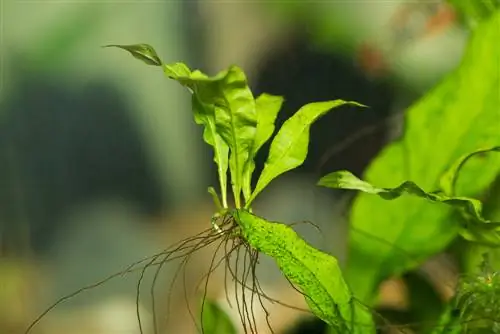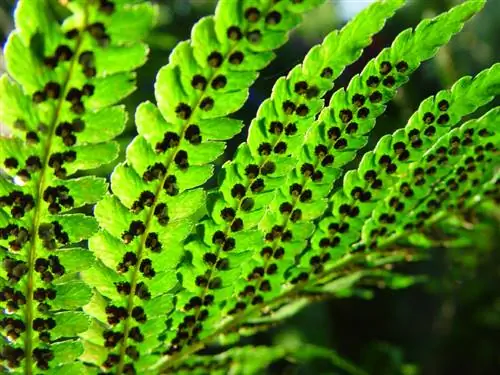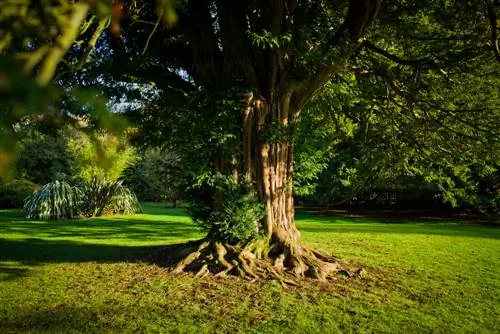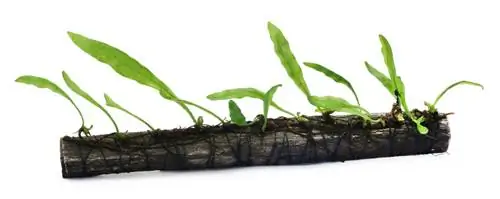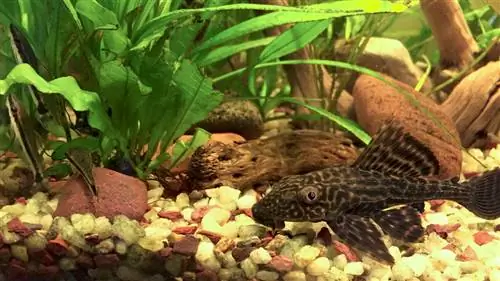- Author admin [email protected].
- Public 2023-12-16 16:46.
- Last modified 2025-01-23 11:22.
Cultivating the Java fern requires basic knowledge about growth. It is an epiphyte that is suitable for growing roots and stones. The plant is known as black root fern and has the scientific name Microsorum pteropus.

How do you attach Java fern to a Java root?
Java root is ideal for Java fern (Microsorum pteropus), an epiphyte that grows on stones or roots. Tie the Java fern to the root with fishing line (€2.00 on Amazon) or twine and remove the attachment as soon as it has grown.
How Java fern grows
The fern plant develops a creeping rhizome, which is densely covered with scales. Tough, hard leaves emerge from this, which are lanceolate in shape and reach a length of around 20 centimeters. In the young stage, the tip of the leaf appears transparent, which later turns completely green. The irregularly wavy edges of the leaves are aesthetic.
Occurrence and ecology
Java fern has its main distribution area in the tropical regions of Asia. Here the species grows in rivers and streams with stony ground that are alternately flooded and dry. The fern needs these conditions in order to reach spore maturity. The spores are formed beneath the leaves when they are not flooded. In water, the plants colonize the roots of aquatic plants.
Use as an ornamental plant
The Java fern is a popular marsh and aquatic plant for aquariums and paludariums. In underwater vegetation, the fern plant prefers stones or plant roots as a base. As epiphytes, the ferns with their free-standing dark roots are a highlight in the aquarium. If it is planted in gravel, the rhizome thrives poorly and becomes stunted. In the reptile terrarium you can also plant the salsify fern in the loose soil.
This is what the fern needs:
- hard to medium hard water
- Fertilization only necessary for hardness levels from 0 to 7
- Temperatures between 20 and 28 degrees Celsius
Tethering
The spotted fern plant allows almost endless design possibilities because it can be tied to various objects. Take a root, place the plant on it and carefully tie it with fishing line (€2.00 on Amazon) or yarn. Alternatively, rubber bands can be used for fastening.
Wire is not recommended as it rusts in water. Another option is to wedge it between two stones, in wood gaps or rocks on the aquarium walls. It is important that you do not damage the root structure. Otherwise there is a risk of rot formation.
Tip
Java moss (Taxiphyllum barbieri) is one of the most popular aquarium moss because it proves to be particularly undemanding when it comes to light and water values.
Tie off
After the fern has grown, you can remove the attachment cords. Over time, it develops adhesive roots that hold the plant underground. If you use stones as a base, you should use green or brown cords. You do not need to remove these as they are not noticeable due to their color.
Propagate
The salsify fern can be easily reproduced by division. Separate part of the rhizome from the mother plant so that the daughter plant has some leaves available. Tie this section to a suitable base using the tying method.

